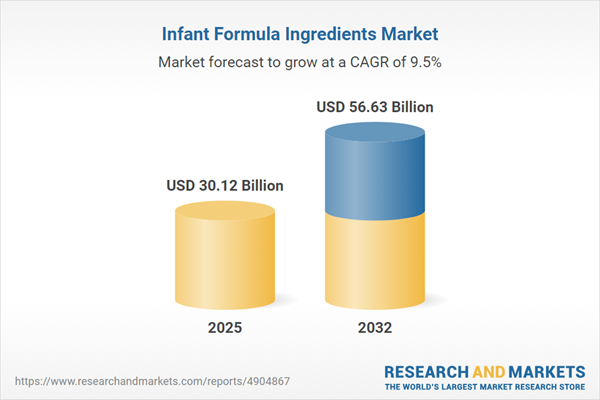Speak directly to the analyst to clarify any post sales queries you may have.
The infant formula ingredients market is undergoing significant transformation, driven by shifts in consumer expectations, regulatory developments, and rapid scientific advancements. Senior decision-makers must navigate a challenging environment to deliver high-performance, compliant, and differentiated nutrition solutions worldwide.
Market Snapshot: Infant Formula Ingredients Market
The global infant formula ingredients market grew from USD 27.48 billion in 2024 to USD 30.12 billion in 2025 and is projected to reach USD 56.63 billion by 2032. The market is experiencing a compound annual growth rate (CAGR) of 9.45%, reflecting robust innovation, evolving regulation, and heightened focus on ingredient transparency. As companies respond to increased scrutiny and consumer demand for cleaner labels, investment in quality assurance and supply chain management is on the rise—positioning the sector for sustained expansion amidst ongoing changes.
Scope & Segmentation
This industry report provides a detailed analysis, covering crucial segments and competitive landscapes essential to forming forward-looking strategies for senior executives.
- Protein Sources: Cow milk protein, goat milk protein, protein hydrolysates (including extensive and partial hydrolysates), and soy protein.
- Forms: Concentrated liquid, powder (pouch, sachet, tin), ready-to-drink (bottle, Tetra Pak).
- Organic Status: Conventional and organic options, including EU organic and USDA organic variants.
- Additives: DHA and ARA enrichment, micronutrient fortification, prebiotic options (fructo-oligosaccharide, galacto-oligosaccharide), and probiotic enrichment (Bifidobacterium, Lactobacillus).
- Lactose Content: Lactose-based and lactose-free formulations tailored to dietary sensitivities.
- Geographic Regions: Americas; Europe, Middle East & Africa; and Asia-Pacific. Comprehensive country-level breakdowns for all major and emerging markets provided.
- Company Profiling: In-depth assessments of leading players, including Fonterra Co-operative Group Limited, Arla Foods amba, Royal DSM N.V., Royal FrieslandCampina N.V., Kerry Group plc, Glanbia plc, Archer-Daniels-Midland Company, Cargill, Incorporated, BASF SE, and Tate & Lyle PLC.
Key Takeaways for Senior Decision-Makers
- Ingredient transparency and ethical sourcing are top priorities as consumer scrutiny intensifies worldwide, particularly in developed and urbanizing markets.
- Regulators are continually updating labeling and compositional requirements, compelling manufacturers to proactively adapt formulations and processes to ensure compliance.
- Scientific advances drive the development of new bioactive compounds, including human milk oligosaccharide analogues, prebiotics, and custom probiotics, enabling more closely tailored products to infant health needs.
- Regional market differences demand a modular, localized strategy—leaders must align formulations with differing regulatory codes, consumer preferences, and distribution models across geographies such as North America, Europe, and Asia-Pacific.
- Agility in supply chain management, highlighted by responses to trade policy such as U.S. ingredient tariffs, is increasingly critical to margin preservation and consistent product availability.
- Partnerships between ingredient firms, contract manufacturers, and innovative startups are shaping the competitive landscape. Cross-sector collaboration enhances speed to market and technology adoption.
Tariff Impact: 2025 U.S. Measures
Recent tariffs introduced in the United States have driven companies to reassess procurement and diversify supply sources. This shift also encourages local production options, though such moves require capital investment and new regulatory adaptation. The capacity to navigate these policy changes is proving a key differentiator in market resilience and long-term success.
Methodology & Data Sources
This report employs a multi-faceted qualitative and quantitative methodology. In-depth interviews with nutrition and regulatory professionals, combined with secondary research from regulatory documents, clinical studies, corporate disclosures, industry reports, and peer review, ensure data validity and actionable insights for decision-makers.
Why This Report Matters
- Empowers executive leadership to anticipate and respond to ongoing regulatory, technological, and market changes, enabling sound investment and product development strategy.
- Provides granular segmentation and competitive benchmarking to support differentiated positioning in both developed and rapidly emerging markets.
- Delivers actionable intelligence to optimize sourcing, leverage innovation, and maintain regulatory compliance across complex global supply chains.
Conclusion
The infant formula ingredients market is evolving rapidly through scientific breakthroughs, shifting consumer and regulatory expectations, and dynamic competitive actions. Executives equipped with deep market intelligence will be optimally positioned to sustain compliance, drive innovation, and capture emerging growth.
Additional Product Information:
- Purchase of this report includes 1 year online access with quarterly updates.
- This report can be updated on request. Please contact our Customer Experience team using the Ask a Question widget on our website.
Table of Contents
3. Executive Summary
4. Market Overview
7. Cumulative Impact of Artificial Intelligence 2025
Companies Mentioned
The companies profiled in this Infant Formula Ingredients market report include:- Fonterra Co-operative Group Limited
- Arla Foods amba
- Royal DSM N.V.
- Royal FrieslandCampina N.V.
- Kerry Group plc
- Glanbia plc
- Archer-Daniels-Midland Company
- Cargill, Incorporated
- BASF SE
- Tate & Lyle PLC
Table Information
| Report Attribute | Details |
|---|---|
| No. of Pages | 185 |
| Published | October 2025 |
| Forecast Period | 2025 - 2032 |
| Estimated Market Value ( USD | $ 30.12 Billion |
| Forecasted Market Value ( USD | $ 56.63 Billion |
| Compound Annual Growth Rate | 9.4% |
| Regions Covered | Global |
| No. of Companies Mentioned | 11 |









